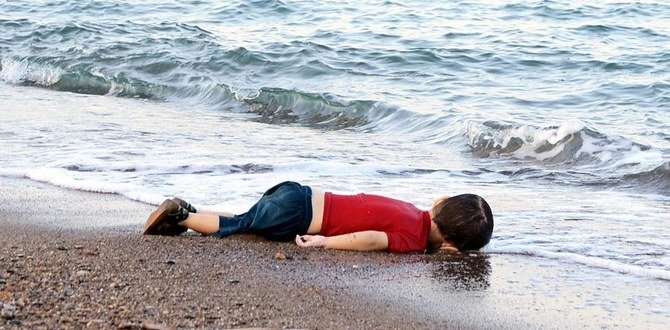
News is like any piece of information – It can be misleading or bent and manipulated to support or hinder a certain viewpoint.
The poster to the right was released days before the EU referendum. The image was taken in Slovenia in 2015 and pictures those who have just crossed the border with Croatia. it uses an image intended to highlight the refugee crisis and spins it to display an imigration problem.
“The image suggests that refugees are somehow to blame for financial issues in the United Kingdom and this is simply not the case.”
Without the facts surrounding this image, you may well believe this is a photograph of the UK where immigrants have crossed the border to inhabit the country.

Of course, this is’nt the first and wont be the last of political storytelling. In 2016, Boris Johnson claimed that we send £350 million a week to the EU and that by leaving the Union we would be able to reinvest that money in the public body.
Sadly, this was a lie. The figure was based on miseleading information which had been twisted with the aim of political gains.
What this really teaches me, is that, while information can come from ‘trusted’, verified sources, it does not always mean that they can be trusted.
In an open and honest way, campaigns like this should be backed up with clear reasoned facts which can easily be checked and the truth determined.
Fake News

When The Washington Post Fact Checker team first started cataloguing President Donald Trump’s false or misleading claims, they recorded 492 suspect claims in the first 100 days of his presidency. On Nov. 2 alone, the day before the 2020 vote, Trump made 503 false or misleading claims as he barnstormed across the country in a desperate effort to win reelection.
This astonishing jump in falsehoods is the story of Trump’s tumultuous reign. By the end of his term, Trump had accumulated 30,573 untruths during his presidency — averaging about 21 erroneous claims a day.
What is especially striking is how the tsunami of untruths kept rising the longer he served as president and became increasingly unmoored from the truth.

“The full horror of the human tragedy unfolding on the shores of Europe was brought home on Wednesday as images of the lifeless body of a young boy – one of at least 12 Syrians who drowned attempting to reach the Greek island of Kos – encapsulated the extraordinary risks refugees are taking to reach the west.” –
The Guardian Newspaper
Sometimes, facts and details cloud a message. A photo, such as the one above, really hits home. It doesn’t need much explanation to make you realise the extent of the tradegy which has unfolded.
This technique has been employed many times over the years in safety campaigns such as no smoking or seatbelts.
The ‘Julie knew her killer’ seatbelt campaign is still firmly lodged in my mind. Simple messaging plus a real, gritty yet slightly grusome outcome.
Makes me wonder if there is a way of combining fact and reality to give a clear and truthful picture which is based on facts and checkable knowledge.
Experience
Another way to show the true depth of an important subject is to engage people in an experiential manner which makes use of all their senses in generating a response.
In the installation by Menashe Kadishman, the sound of the clanking iron plates as you walk over them are intended to remind you of the Jews that are missing from German Society.
This to me, mainly acts as an art installation and therefore has many interpretations depending on who you are and how you perceieve the experience.
To me, it has two main threads. Firstly, the sounds emitted by walking over the faces would be a reminder of the pain and suffering that each person had gone through.
Secondly, it represents that the ‘missing Jews’ made sacrafices so you could walk, free, in that gallery.
Men are not OK – Workshop Challenge
This week we want you to explore your own methods of communicating a story through information design. You will be assessed on the visual impact and also the effectiveness of your communication. Take stock of what you have learned about data visualisation and the importance of clarity. Please consider the format and materials used, which can help tell your story.
Male suicide and mental health is often thought of as a taboo subject with many men reluctant to share their emotions and experiences with others.
A man is three times more likely to commit suicide than a woman and sadly was the leading cause of death in those under 50 in 2014.
On a day in January 2004, 28 men sadly took their own lives in the United Kingdom. With no prescriptive and determined manner, the suicides take place across the county and is estimated to happen once every two hours.
Reflection
On reflection of this weeks project, I wish I had involved a wider range of sources and techniques.
A real life suicide story from the view point of the deceased’s loved ones would have grounded the piece and made it feel real.
An art installation where you would feel trapped and drowning, clouded by your own judgement, would serve to allow the user to experience some of the feelings male suicides felt.
I have stuck to truth and fact in my inforaphic but do wonder, if I was to exacerbate these figures to make the message stronger or more extreme, would a potential audience pay more attentiion to it?

References
Safdar, A., 2016. Brexit anti-immigration poster ‘demonises refugees’. [online] Aljazeera.com. Available at: https://www.aljazeera.com/features/2016/6/28/brexit-ukips-unethical-anti-immigration-poster [Accessed 14 May 2021].
Kentish, B., 2017. Boris Johnson ‘misused’ figures with £350m Brexit claim, UK statistics chief says. [online] The Independent. Available at: https://www.independent.co.uk/news/uk/politics/boris-johnson-350m-brexit-nhs-misled-uk-statistics-authority-telegraph-sir-david-norgrove-amber-rudd-a7951711.html [Accessed 14 May 2021].
Kessler, G., Rizzo, S. and Kelly, M., 2021. Trump’s false or misleading claims total 30,573 over 4 years. [online] Washington Post. Available at: https://www.washingtonpost.com/politics/2021/01/24/trumps-false-or-misleading-claims-total-30573-over-four-years/ [Accessed 14 May 2021].
Smith, H., 2015. Shocking images of drowned Syrian boy show tragic plight of refugees. [online] the Guardian. Available at: https://www.theguardian.com/world/2015/sep/02/shocking-image-of-drowned-syrian-boy-shows-tragic-plight-of-refugees [Accessed 14 May 2021].
Youtube.com. 2009. Julie knew her killer – seatbelt road safety advert [online] Available at: https://www.youtube.com/watch?v=mKHY69AFstE [Accessed 14 May 2021].
Lee, H., 2013. My Berlin: Shalechet (Fallen Leaves) at the Jewish Museum. [online] Fotoeins Fotografie. Available at: https://fotoeins.com/2013/04/02/shalechet-jewish-museum-berlin/ [Accessed 14 May 2021].
Samaritans. 2021. Suicide facts and figures. [online] Available at: https://www.samaritans.org/about-samaritans/research-policy/suicide-facts-and-figures/ [Accessed 14 May 2021].
Mental Health Foundation. 2021. Statistics | Mental Health Foundation. [online] Available at: https://www.mentalhealth.org.uk/statistics [Accessed 14 May 2021].
Ons.gov.uk. 2019. Suicides in England and Wales – Office for National Statistics. [online] Available at: <https://www.ons.gov.uk/peoplepopulationandcommunity/birthsdeathsandmarriages/deaths/bulletins/
suicidesintheunitedkingdom/2019registrations> [Accessed 14 May 2021].

Leave a Reply